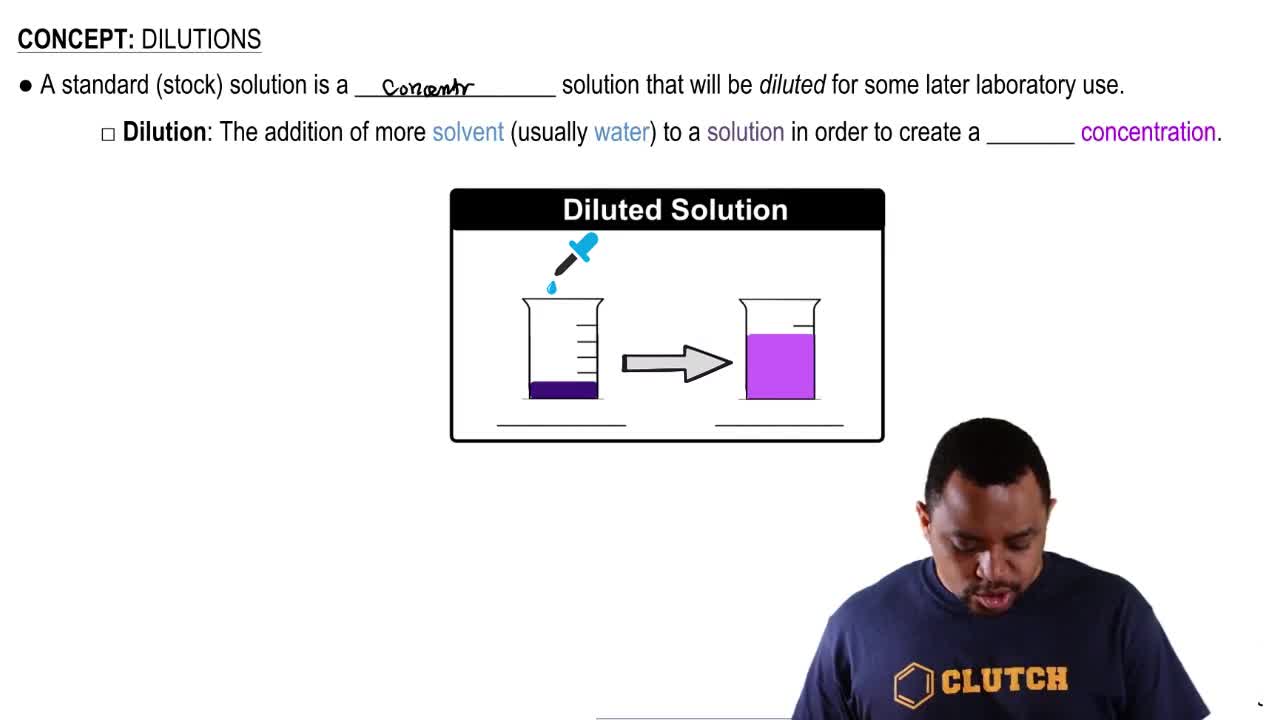Calculate the number of moles of solute present in each of the following aqueous solutions: (c) 124.0 g of a solution that is 6.45% glucose (C6H12O6) by mass.
Ch.13 - Properties of Solutions
Chapter 13, Problem 53b
Describe how you would prepare each of the following aqueous solutions, starting with solid KBr: (b) 125 g of 0.180 m KBr,
 Verified step by step guidance
Verified step by step guidance1
Calculate the moles of KBr needed: Use the formula for molality, \( m = \frac{\text{moles of solute}}{\text{kg of solvent}} \), to find the moles of KBr required. Rearrange the formula to find moles: \( \text{moles of KBr} = m \times \text{kg of solvent} \).
Determine the mass of water needed: Since the problem specifies 125 g of solution, convert this mass to kilograms (0.125 kg) and use it as the mass of the solution. Subtract the mass of KBr (which you will calculate next) from the total mass of the solution to find the mass of water.
Calculate the mass of KBr: Use the molar mass of KBr (approximately 119 g/mol) to convert the moles of KBr (calculated in step 1) to grams.
Mix the KBr with water: Weigh the calculated mass of KBr and dissolve it in the calculated mass of water (from step 2) to prepare the solution.
Ensure complete dissolution: Stir the mixture until all the KBr is completely dissolved in the water, ensuring a homogeneous solution.

Verified video answer for a similar problem:
This video solution was recommended by our tutors as helpful for the problem above.
Video duration:
3mWas this helpful?
Key Concepts
Here are the essential concepts you must grasp in order to answer the question correctly.
Molarity
Molarity (M) is a measure of concentration defined as the number of moles of solute per liter of solution. It is crucial for preparing solutions, as it allows chemists to quantify how much solute is needed to achieve a desired concentration. In this case, a 0.180 M solution of KBr means that there are 0.180 moles of KBr in every liter of the solution.
Recommended video:
Guided course

Molarity
Moles and Molar Mass
To prepare a solution, it is essential to understand the relationship between moles and molar mass. The molar mass of KBr is approximately 119.0 g/mol, which means that one mole of KBr weighs 119.0 grams. To find out how many grams are needed for a specific molarity, you can use the formula: grams = moles × molar mass.
Recommended video:
Guided course

Molar Mass Concept
Dilution and Solution Preparation
Preparing a solution involves dissolving a specific amount of solute in a solvent, typically water, to achieve the desired concentration. For the given problem, you would first calculate the number of moles required for 125 g of a 0.180 M KBr solution, then weigh out the appropriate mass of KBr, and finally dissolve it in enough water to reach the total volume of the solution, ensuring thorough mixing.
Recommended video:
Guided course

Solution Dilution Process
Related Practice
Textbook Question
Textbook Question
Calculate the number of moles of solute present in each of the following solutions: (a) 255 mL of 1.50 M HNO3(aq),
Textbook Question
Describe how you would prepare each of the following aqueous solutions, starting with solid KBr: (c) 1.85 L of a solution that is 12.0% KBr by mass (the density of the solution is 1.10 g/mL)
Textbook Question
Describe how you would prepare each of the following aqueous solutions, starting with solid KBr: (d) a 0.150 M solution of KBr that contains just enough KBr to precipitate 16.0 g of AgBr from a solution containing 0.480 mol of AgNO3.
Textbook Question
Describe how you would prepare each of the following aqueous solutions: (a) 1.50 L of 0.110 M 1NH422SO4 solution, starting with solid 1NH422SO4;
